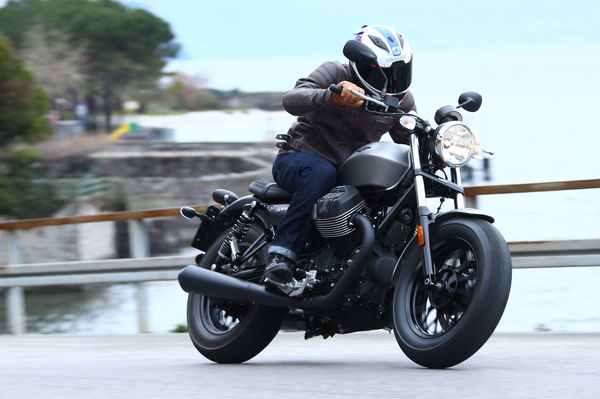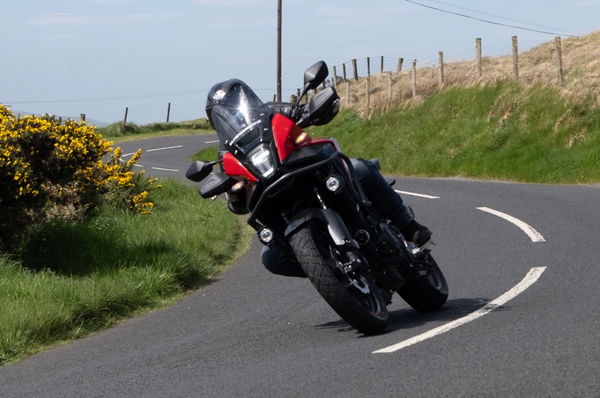First ride: Ducati Mulistrada 1200 Enduro Review
Ducati’s new Multistrada 1200 Enduro comes out swinging, with genuinely good off-road performance and road handling to match

DUCATI’S Multistrada has never been a bike that pretended it was truly capable off-road. Its upright position is a comfortable disguise for the road-focused weapon underneath. For many years it seemed that was as close to off-road as Ducati would ever get. What sits before us now is a bike that Ducati have pointed squarely at the dirt.
On paper it’s a big challenge to see how Ducati, a company with zero knowledge or heritage in off-road, would go about turning their upright, tarmac ripping, 160hp Multistrada into a bike comfortable on dirt.
The crux of the story is that they changed everything bar the engine and frame, creating a bike that the Italian brand wanted to be capable of swallowing any terrain in its path with with skill, comfort and grace. By replacing almost every single major part and altering most of the fundamental dimensions, they’ve truly achieved this.
The fuel capacity has been increased to a whopping 30 litres and the suspension travel is lengthened to 200mm. A 19-inch front wheel joins the new forks, with wire-spoke wheels as standard. The new double-sided swing-arm is stiffer, more balanced and longer, thus the whole bike is stretched some 65mm. They’ve changed the front axle offset, increased the rake by a degree, upped the ground clearance and completely changed the riding ergonomics of the bike. This means new handlebars and risers that sit 50mm higher, a new seat, chunky steel foot-pegs, a folding tip steel gear lever and a height-adjustable brake pedal.
The main frame design remains identical to the sister Multistrada, as is the engine. To gain more torque at the rear wheel, the rear sprocket is now three teeth bigger (43-tooth) and all the electronic riding modes have been calibrated to match the chassis changes. This applies to the suspension damping (DSS), ABS, traction control (DTC), anti-wheelie (DWC), throttle response and fuel injection.
There are numerous other, smaller alterations including new mirrors stems, grab handles, a longer front beak, a frame-mounted sump-guard and a new rear silencer designed to sit higher and allow maximum room for the Touratech panniers that come in the optional Touring accessory package.
As I swung my leg over the very reasonable 870mm seat height, one thing became instantly apparent. The new 1200 Enduro is not a rehashed Multistrada with wire-spoke wheels. Everything about the bike is dramatically more dirt friendly. It’s remarkably slim through the middle and easy to get feet down.
The 70km off-road portion of the test ride couldn’t have shown the bike in a better light, with a packed sandy trail winding its way up the mountain, providing great grip and feeling. The Multistrada Enduro quickly showed its ability, with the comfort, precision and balance of a bike totally at home on dirt. It’s a world apart from its sister.
Every single element of the ergonomics is perfectly positioned to allow you to operate the bike as needed. There are no hindrances, nothing to catch your feet on, nor mirrors hitting forearms and it makes a huge difference to the ride. Between your legs the bike is slim and smooth. The handlebars are a fantastic bend and high enough that only the very tallest riders will struggle. The whopping foot-pegs provide a great connection to the bike, allowing little adjustments and inputs that translate well. Instead of feeling like a road bike off-road, it’s sharp, effective and very playful.
Kerb weight including a 90%-full tank is 254kg, but the Multistrada Enduro carries itself well. It feels balanced to ride and turns precisely and smoothly. It’s predictable and readable, and the chassis provides good feedback, allowing you to do everything you want at all times, be it backing the bike in, throwing power-slides or cruising the trail.
The engine is a huge asset, smooth and easily controlled. In Enduro mode the power is set to 100hp but this remains more than enough. As the revs grow the bike gains speed incredibly quickly. However, at no point is it aggressive, a handful or intimidating. It builds in a linear fashion, especially at low revs. The ride-by-wire throttle provides a huge range over which the power is spread, allowing for very precise and accurate modulation of the rear wheel. The end result is a bike that is easy to control and find grip on.
As well as being incredibly easy to ride fast and dramatically, the bike was equally comfortable at slow, technical riding. Novice or even first-time off-road riders will find a huge area of the power that is usable, friendly and gentle in delivery.
That smooth character combines well with the chassis to create a bike that is incredibly manageable and easy to ride off road. The ABS and traction control systems also perform superbly and add dramatically to the accessibility of the 1200 Enduro. The ABS was a standout feature, with performance remarkably close to the limit of grip available. It’s a system that 85% of the time is capable of dealing with the ground in an efficient and ultimately safe way. It makes the bike more stable under braking and quickly gets the job done. In Enduro mode it works only on the front brake, with the rear brake still able to be locked.
The traction control system is efficient and smooth, interfering very gently and allowing the rear to slide a nice amount before holding it in place. It’s a little more limited than the ABS. Making good progress was easier with it switched off, but it’s pretty capable nonetheless.
The Multistrada Enduro is also a dramatically different animal to its stablemate on-road. The bikes were set up a little differently for this part of the test, with handlebars rolled back a touch and fitted with Pirelli Scorpion Trail II tyres and the Touring accessory pack, including Touratech panniers. Foot-pegs rubbers were installed too.
In Touring mode the Multistrada Enduro offers a relaxed ride, with a soft, spongy feeling from the suspension. It’s comfortable for riding on straight roads and would be optimum motorway miles. The engine response is also softer, almost lazy – it never really seems to takes off with the vigour you expect.
As the roads began twisting, Touring mode quickly started to unravel and the comfortable, soft suspension was entirely detrimental to handling, regardless of the speed you wanted to ride. It wallowed about and was easy to upset in corners. In turn, this made holding a good line a little more difficult than it should have been.
A couple of button presses later and things dramatically improved. Sport mode stiffens the suspension to the very hardest setting on the fork and shock. Throttle response is dramatically sharper and it became a much easier bike on the Sardinian coastal roads, regardless of the speed. It was more planted in the turns, more precise and managed its size with for more comfort.
The chassis is a stable and assured platform. It feels longer and a little slower to flick between turns than its sister, but that’s no surprise. It is surprisingly easy to turn and the wide handlebars definitely have a hand in this. It’s not a difficult bike to ride on the road and generally required a low level of input to lean over. In this area it isn’t the most nimble in class, but it is still very good.
Getting the set-up right in the settings menu helped and we added some more pre-load to the shock to help it sit a little more on the front end. Even on the hardest damping setting, it was still a little soft, but on this class of bike there will always be some compromise. Despite that, it’s still capable of being exceedingly quick on the road.
As a complete package Ducati have knocked the ball a long way out of the proverbial park. It was very difficult to find much wrong with the bike during the 125 miles we rode. The performance off-road was incredibly good. It’s planted, easy to ride and unbelievably capable.
On the road it’s lost some of its sister model’s edge, but gains versatility. The 870 mm seat-height (850mm with an optional low seat) is low for an adventure bike and the machine feels substantially lighter than it seems to have a right to. It’s easy to control in town and never feels top heavy or unbalanced. Most importantly, it kept me smiling all day.
The most noticeable difference between this and the Multistrada is in rideability. Despite its weight gain, the mapping and gearing alterations have made the Enduro a bike that feels more accessible. Around town it’s easy to ride, well balanced and the floor never seems far away. At no point did it feel intimidating or ungainly. Ducati have made the mapping and gearing something that can be retro-fitted to existing Multistradas.
One problem lies with the mirrors and hand-guards. The gorgeous hand-guards with integrated indicators didn’t stand up well to crashing – another ride broke one. The mirrors lacked sufficient adjustability when the clutch and brake levers were moved down for riding off-road. Nice view of the sky but not much else.
But those are small concerns in a fantastic overall package. The Multistrada Enduro has loads of character and makes a unique machine its class, with a phenomenal sound from that V-Twin engine. It’s a motorcycle that anyone, of any experience level, could swing their leg over and love, on or off road.
For that Ducati deserve a round of applause.
CLICK HERE TO WATCH OUR VIDEO REVIEW OF THE DUCATI MULTISTRADA 1200 ENDURO
Model tested: Ducati Multistrada 1200 Enduro
Price: £16,690 plus on-the-road charges
Engine: 1198.4cc Testastretta V-twin, variable valve timing, four valves per cylinder, dual spark, Desmodromic, liquid cooled
Power: 160hp @ 9,500rpm
Torque: 100.3lbft @ 7,500rpm
Kerb weight: 254kg
Frame: tubular steel trellis
Suspension: Sachs 48mm fully-adjustable USD fork, electronic compression and rebound damping adjustment with Ducati Skyhook Suspension (DSS); fully adjustable Sachs shock, electronic compression, rebound damping and spring pre-load adjustment with Ducati Skyhook Suspension (DSS). Aluminium double-sided swingarm.
Brakes: Twin 320mm semi-floating front discs with radially mounted four-piston monoblocco Brembo calipers; 265mm rear disc with two-piston floating caliper. Cornering ABS as standard equipment.
Tyres: Pirelli Scorpion Trail II, 120/70-19 front, 170/60-17 rear (or optional Pirelli Scorpion Rally in same sizes)
Seat height: 870mm non-adjustable (850mm or 890mm with optional low and high seats)
Fuel capacity: 30 litres
Colours: Phantom Grey, Star White Silk, Red
Accessory packs:
Enduro Pack - £ 799.64
Bar Protectors
Lower Chain Guard
Rear Brake Guard
Radiator Protector
Oil Radiator Protector
Auxiliary Fog Lamps
Urban Pack - £853.00
Aluminium Touratech Top Case
Tank Bag and Locking Flange
Cable for USB Socket
Sport Pack - £917.10
Billet Resevoir Caps
Ducati Performance by Termignoni Homologated Silencer
Billet Aluminium Water Pump Cover
Touring Pack - £1,493.60
Aluminium Touratech Side Panniers (45 litre left and 40 litre right)
Handlebar Bag
Heated Grips











